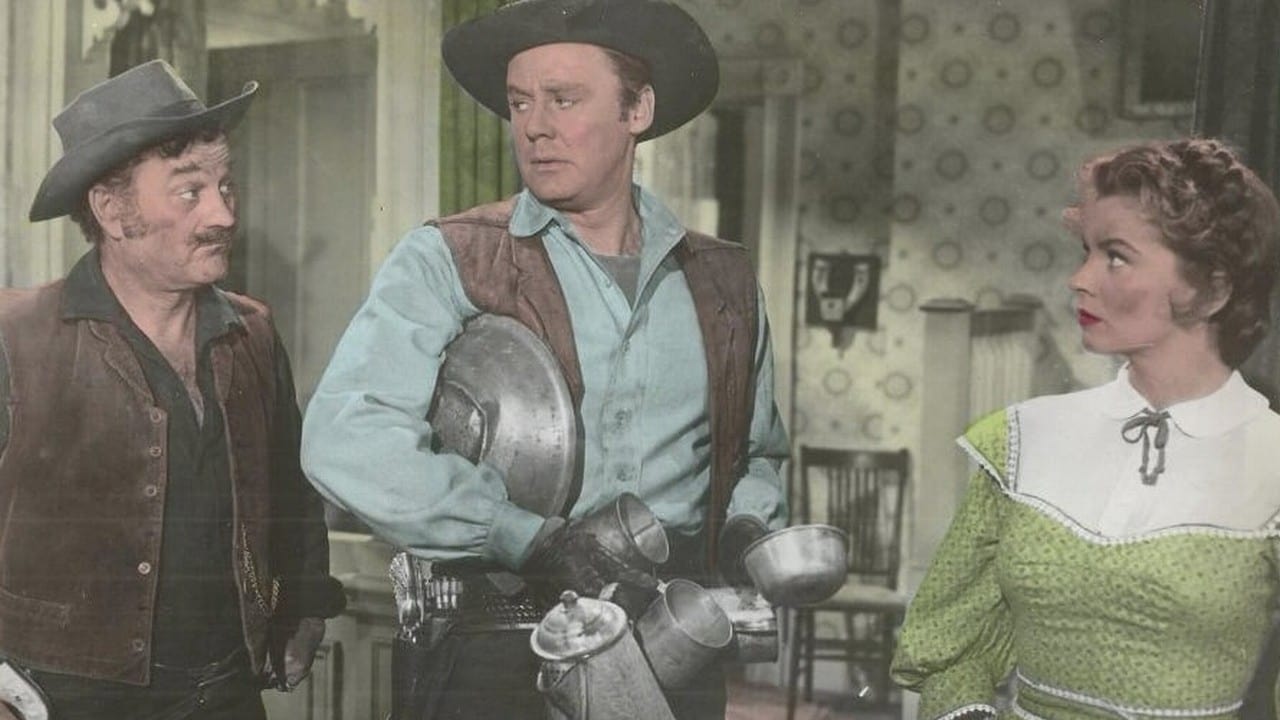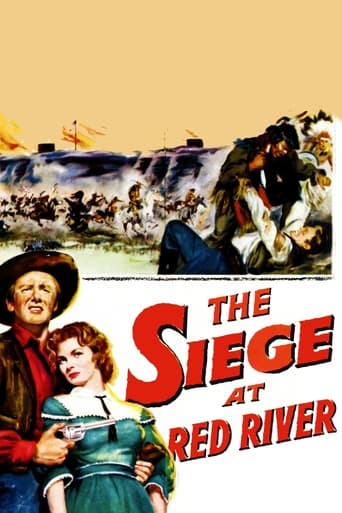



I like the storyline of this show,it attract me so much
View MoreIt’s an especially fun movie from a director and cast who are clearly having a good time allowing themselves to let loose.
View MoreAmazing worth wacthing. So good. Biased but well made with many good points.
View MoreThrough painfully honest and emotional moments, the movie becomes irresistibly relatable
View MoreIt's a typical 50's Technicolor Western trotting out all the usual ingredients with the usual vim – no-nonsense people and plot was the motto.Two Rebs steal the being-developed Gatling Gun from the Feds in an ingenious segment, eventually toting it further south but ending up stuck in a small town. This town gets quickly filled to the brim with Federal soldiers still on the hunt for their gun. Van Johnson (Reb) and Joanne Dru (Fed) fall for each other of course although of course they don't realise it until the climax. What interested me was the implication that the gun could be used by civilised whites against each other in a civilised slaughter but that selling it to the savage Reds was beyond the Pale. Both Feds and Rebs are eventually united to prevent the Reds using it during the noisy 5 minute siege. And of course the implication was only the Reds were low enough to actually use the horrible weapon the Feds had had the brains to design – at the time of production America had the same idea about the Russian Reds and the atom bomb.It has a bit of everything Western in: romance and fights, trains and horses, shootings and slapstick comedy. It's fun, I loved it.
View MoreTwo Confederate agents (Van Johnson and Milburn Stone) head west in order to bring a Gatling gun back to the South in the hopes of winning the Civil War. In order to travel with the famous gun through hostile Commanche territory they hire Indian trader Richard Boone to lead the way. Johnson and Stone hide their true identities by masquerading as sales reps for a cure all tonic and actually perform a song together in order to draw in a crowd. Amongst the crowds are various Confederate sympathizers who slip them concealed notes about where to go next. Also in the mix is Joanne Dru who plays a health care provider and who falls for Johnson's ruse as the tonic sales rep while gradually discovering his true Confederate identity. The action is mostly laughable, especially a big fight with Indians, though they (the Commanches) do get their hands on the Gatling gun and get a chance to use it. However, any film with Richard Boone in it is worth watching. He does not disappoint here as a sore tempered loser at poker and treacherous Indian trader. A few years later the film Rio Conchos portrayed a similar story of the Civil War out west, and this one also starred Boone. It's about ten times better than Siege At Red River.
View MoreSiege At Red River is a Civil War western which casts Van Johnson and Milburn Stone as a couple of Confederate spies who steal a prototype new Gatling Gun from the Union Army and hope to get it south so that their army can get it in the field and turn the war's tide. Students of history will note that there is a scene shortly after they accomplish the heist showing that Lincoln has been safely re-elected and that was on the heels of Sherman taking Atlanta. We know if Van and Milburn don't that they're fighting a lost cause.But we can't have loose Gatling Guns around and Army Intelligence Officer Jeff Morrow is on the trail of the thieves. Johnson and Stone are a wily pair and con Union Army nurse Joanne Dru into innocently transporting the weapon with her medical supplies. But another guy who they use for aid, outlaw renegade Richard Boone has an agenda all his own and it involves the Indians.I don't think I have to go any farther, anyone who's seen enough films and knows off history knows how this will end generally. How it ends for the principal cast members you see the film for.What I liked about Siege At Red River is that Van Johnson and Milburn Stone in their guise as medicine show hucksters got to do a little snappy patter and song in the film. Johnson started out as a chorus boy on Broadway and he was brought to Hollywood after a bit part on Broadway in Too Many Girls. Occasionally he did do some singing and dancing, but not enough in my humble opinion. Peggy Maley also does a nice number in the saloon and she was great also.Maley is Richard Boone's girl and when Richard Boone is mean on the screen there ain't nobody meaner. His villains are usually quite irredeemable creatures with no decent characteristics.The final attack of the Indians and the soldiers counterattack is staged very well. Nice location cinematography for this, it was not the kind of sequence that could reasonably been done on a studio back lot any longer. Definitely a good western and I believe the only one Van Johnson ever did in his career.
View MoreIn 1954, a Western about the Civil War is not just about the Civil War. 'Siege at Red River' opens with the robbery of a Union train by a bunch of outlaws. The Union soldiers, including a detective, combine the Military and the Law - they are protecting a secret new super-weapon - the Gatling Gun, the first example of mechanised warfare which means surefire victory for which ever side possesses it. If we substitute the Gatling with a nuclear warhead, the Civil War with the Cold War; and if we note that the bandits make off in a red mail van, and that their leader wears a red cravat, and we assume them as commies, than the Western becomes an Allegory. This is not surprising - from its inception the genre has celebrated the UNITED States and played out and resolved its crises, while the likes of President Reagan have used it to signify a sense of genuine Americanness, so it is natural the genre should be marshalled in such a time of perceived crisis.As the film is directed by the great Rudolph Mate, former cinematographer for, among others, Carl Dreyer, one of the genuine maestros of the cinema, we might assume that if his film is a Cold War Allegory, it will be far from simplistic. The linking of Communism with disruption, criminality, secrecy and murder is not a surprise; if we do make the link, when our first shock is that the bandit leader is played by the film's star. The benefits of the star persona - wit, charm, a (relatively) rounded personality (he is a grim avenger and gun smuggler, but also a musician, orator and gentleman; he is connected with role-play and the theatre) are in contrast with the monolithic forces of law and order; while he has multiple interests besides the war, they have only that defining interest. Further, while his motives are essentially decent and right-minded, the 'good' guys are not only street-bawling thugs, but perpetrators of vile, near-genocidal acts. The film doesn't go so far as to salvage Farraday's oppositional position - the conflict between North and South is on one level displaced on gender, where it can be resolved in romance; and on another, generic level, displaced on a third enemy - the murderous amoral smuggler and the Indians - so the opposing American forces can finally reconcile. But it's not a happy reconciliation - the massacre of the Indians is only cathartic if we ignore that they too, like the Americans in the Fort, have women and children; and the finale is only happy if we accept the couple's words, and not the narrative reality, that he is an outlaw evading justice and leaving the woman he has learned to love. This fact of separation from the site of reconciliation implicitly questions that reconciliation. There are other features - the anti-realistic use of colour; the drunk scene, where the dominant male point of view suddenly switches to the drunken, gun-shooting female, linked to her frank, disruptive, transformative sexuality and contrasted with the ship-lashing, neurotic villain; the use of song, espeically 'Tapioca', and its movement from rebel code to music hall; the argument that nation is an arbitrary series of signs - the Indians shoot first at the US flag, not the army; the image of the Niagara Falls on the music hall curtains - where national identity is constructed and negotiated, not 'natural'; a sophisticated attitude to patriotism, war and friendship - that all add up to a more thoughtful Western than its routine reputation might suggest.
View More